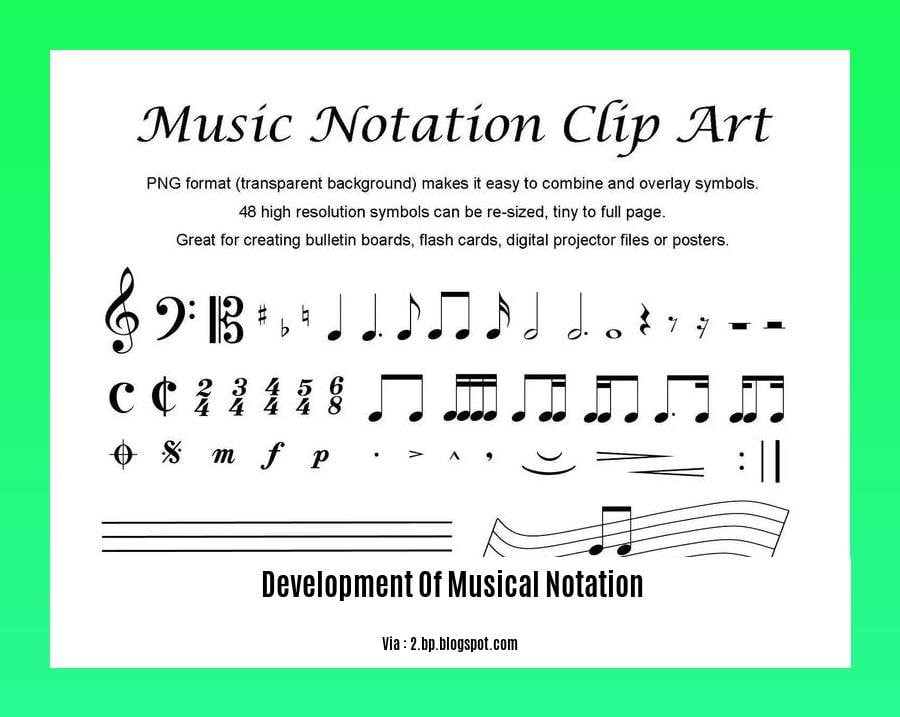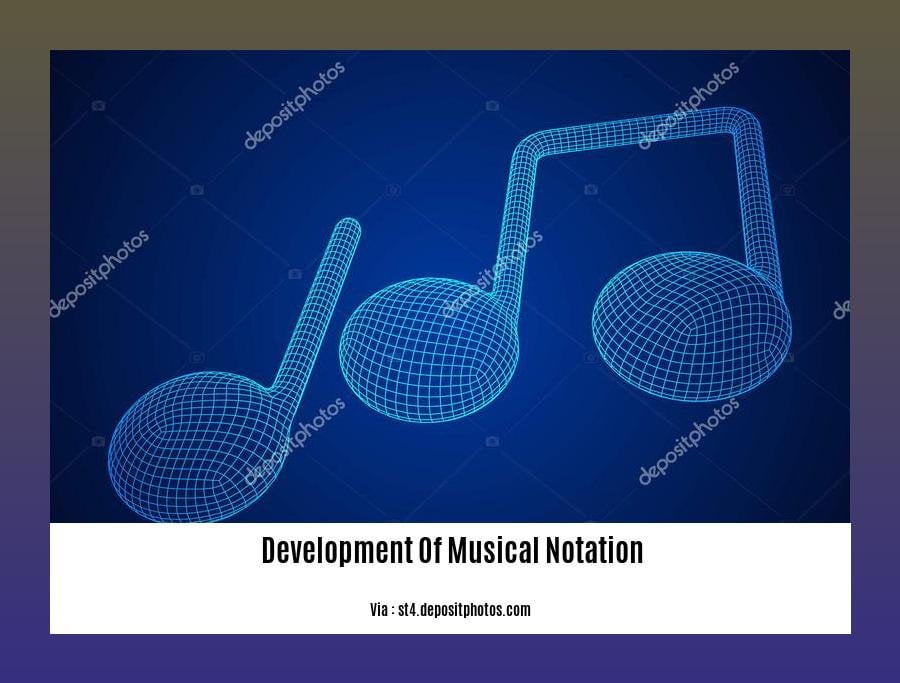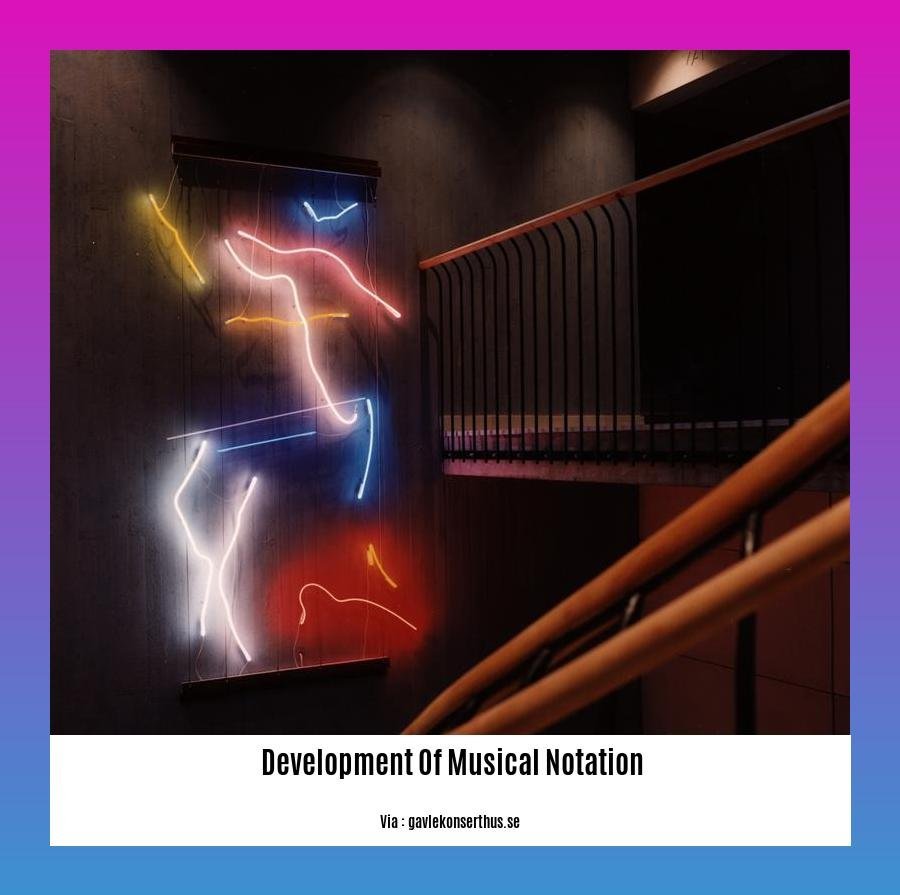Embark on a captivating journey through the ages with “- The Development of Musical Notation: A Historical and Theoretical Exploration.” Delve into the rich history of musical notation, tracing its evolution from humble origins to the sophisticated system we know today. Explore the transformations of noteheads, rhythms, clefs, and more, uncovering the fascinating interplay between technological advancements and cultural contexts that shaped this essential tool for musical expression.
Key Takeaways:
- Musical notation enabled the accurate recording of music, ensuring its intended performance.
- It facilitated the development of polyphonic music by allowing the notation of multiple voices.
- Music notation has evolved throughout history, adapting to new musical instruments and styles.
The Development of Musical Notation

Throughout history, musical notation has played a pivotal role in shaping our musical experiences. It has enabled us to preserve and share musical ideas, leading to the flourishing of diverse musical traditions around the world.
Historical Evolution
The roots of musical notation can be traced back to ancient civilizations. By the 1st century CE, the Greeks developed a system of letter names (A to G) to denote pitch, but this system lacked rhythmic information. In the 9th century, Guido d’Arezzo introduced neumes, symbols placed above or below text, providing a crude indication of melody. The development of staff notation in the 11th century revolutionized music notation, allowing for more precise pitch and rhythmic representation.
Over the centuries, musical notation continued to evolve, reflecting changes in musical styles and the invention of new instruments. The addition of bars, clefs, and other symbols provided greater clarity and flexibility. By the 16th century, the modern staff notation system had emerged, allowing composers to write music with unprecedented complexity and precision.
Significance of Musical Notation
The development of musical notation held immense significance for several reasons:
- Accurate Notation: It allowed composers to record their music accurately, ensuring that it could be performed as intended by others.
- Polyphonic Music: After 1040 CE, musical notation paved the way for the development of polyphonic (multi-voiced) music, enriching the musical landscape.
- Musical Preservation: Notation enabled the preservation of musical works, allowing musicians to revisit and study compositions from earlier eras.
- Educational Tool: Music notation serves as a powerful educational tool, facilitating music theory and performance training.
Today, musical notation continues to be indispensable in the world of music. It is used by musicians of all levels, from students to professional composers, to create, perform, and analyze music. As technology advances, new methods of musical notation are emerging, but the basic principles established centuries ago remain the foundation of our musical communication.
Discover the evolution of music through the ages with our in-depth exploration of the history of music. Explore the captivating eras from classical to modern, with a focus on the classical music era and its influential composers. Delve into the diverse world of modern music genres and discover the sounds that shape our contemporary musical landscape.
Development of Rhythmic Notation: Capturing the Flow of Time in Music

Picture the ebb and flow of music—the gentle undulations, the playful skips, and the dramatic pauses. Rhythm, the heartbeat of music, captures this dynamic energy, and notating it has been a journey of innovation and refinement.
Genesis: Rhythmic Modes and Neumes
In the 12th century, rhythmic modes emerged, allowing musicians to express rhythm in conjunction with melodies. These modes dictated patterns of long and short notes, shaping the flow of music.
Earlier, neumes—symbols resembling hooks and slashes—were used to indicate melody. These rudimentary notations, however, lacked precision in capturing rhythm.
Evolution: Notes and Modern Notation
From the 9th to the 14th centuries, neumes gradually evolved into precise notes, initially square-shaped, then rounded. This shift allowed for more accurate rhythmic notation.
Over time, composers introduced bars and clefs to enhance clarity and flexibility. The modern staff notation, developed around the 16th century, provided a comprehensive system for capturing rhythm and pitch, enabling the intricate polyphonic masterpieces of the Renaissance and beyond.
Capturing the Flow
The Development of Rhythmic Notation: Capturing the Flow of Time in Music has been a remarkable journey, mirroring the evolution of music itself. The ability to notate rhythm has allowed composers to freeze moments in time, preserve musical heritage, and inspire generations of musicians.
Key Takeaways:
- Rhythmic modes (12th-13th century) enabled the notation of rhythm alongside melodies.
- Neumes (9th-14th century) gradually transformed into precise notes.
- Bars and clefs enhanced clarity and flexibility in rhythmic notation.
- Modern staff notation (16th century onwards) provides a comprehensive system for capturing both rhythm and pitch.
Relevant URL Sources:
- A Brief History of Musical Notation from the Middle Ages to the Present
- The Development of Western Music Notation – A Pianist’s Perspective
Clefs and Transposition: Unlocking the Secrets of Pitch
Imagine a musical landscape where different instruments speak in their own unique languages, each with its own pitch and range. To navigate this sonic tapestry, we need a system that translates these diverse voices into a common language: musical notation. Enter clefs and transposition, two essential elements that unlock the secrets of pitch.
Clefs: The Notational Guardians of Pitch
Clefs are the gatekeepers of the musical staff, assigning specific pitches to lines and spaces. The two most familiar clefs are the treble clef (for higher pitches) and the bass clef (for lower pitches). Like a musical key, clefs open the door to understanding the language of pitch.
Transposition: Translating the Unseen
Some instruments, known as transposing instruments, don’t play in the same key as they are written. Imagine a clarinet playing a C, but the music says it’s an E flat. This is transposition at play! Transposing instruments sound at a different octave or interval from what’s written on the page. It’s like translating from one language to another, ensuring that the musical message is conveyed accurately.
Key Takeaways:
- Clefs indicate which pitches correspond to lines and spaces on the musical staff.
- Transposing instruments play at a different pitch than written, requiring musical “translation.”
- The treble clef is used for higher pitches, while the bass clef is for lower pitches.
Most Relevant URL Sources
- Clefs, Pitch, and Transposition in Vocal Music before 1600
- SFCM Musicianship and Music Theory
Technological Advancements and Cultural Influences: Shaping the Evolution of Notation
Technological Advancements and Cultural Influences: Shaping the Evolution of Notation
The evolution of music notation is a fascinating tale of technological advancements and cultural influences. As time passed, notation became more refined and exact, reflecting the growing complexity of music and the evolution of cultural norms.
The Role of Technology
Technology has played a crucial role in the development of musical notation. The invention of the printing press in the 15th century made it possible to mass-produce printed music, which led to a wider dissemination of musical knowledge and accelerated the spread of new notational ideas. In the 20th century, the invention of electronic music and the computer revolutionized the way music is composed, performed, and recorded.
The Influence of Culture
Culture has also had a profound impact on the evolution of musical notation. Different cultures have developed their own unique systems of notation, reflecting their musical traditions and values. For example, the Western staff notation system, which we use today, is based on the musical practices of medieval Europe.
Key Takeaways:
- The evolution of musical notation has been shaped by both technological advancements and cultural influences.
- Technology has enabled the mass production and dissemination of music, and has revolutionized the way music is composed and recorded.
- Culture has influenced the development of different systems of notation, reflecting diverse musical traditions and values.
Most Relevant URL Sources
- The History of Musical Notation
- The Role of Culture in the Evolution of Music Notation
FAQ
Q1: How did musical notation evolve from rudimentary marks to a sophisticated system of symbols?
Q2: How did the development of polyphonic music influence the evolution of musical notation?
Q3: How have technological advancements contributed to the development of musical notation?
Q4: How does the evolution of musical notation reflect the changing musical culture and context?
Q5: What are the key theoretical principles that underlie the development of musical notation?
- Unveiling the Enigma: Mansoureh Khojasteh Bagherzadeh’s Public Appearances & Private Life in Iran - July 18, 2025
- Unveiling the Mystery: Mansoureh Khojasteh Bagherzadeh’s Husband: A Rare Glimpse into a Private Life - July 18, 2025
- Unveiling Masoud Khamenei’s Mother: Power, Influence, and Iran’s Future - July 18, 2025
















